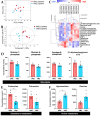Comparative Metabolomics of Small Molecules Specifically Expressed in the Dorsal or Ventral Marginal Zones in Vertebrate Gastrula
- PMID: 35736498
- PMCID: PMC9229639
- DOI: 10.3390/metabo12060566
Comparative Metabolomics of Small Molecules Specifically Expressed in the Dorsal or Ventral Marginal Zones in Vertebrate Gastrula
Abstract
Many previous studies have reported the various proteins specifically secreted as inducers in the dorsal or ventral regions in vertebrate gastrula. However, little is known about the effect on cell fate of small molecules below 1000 Da. We therefore tried to identify small molecules specifically expressed in the dorsal marginal zone (DMZ) or ventral marginal zone (VMZ) in vertebrate gastrula. Small intracellular and secreted molecules were detected using explants and supernatant samples. Hydrophilic metabolites were analyzed by capillary ion chromatography-mass spectrometry and liquid chromatography-mass spectrometry, and lipids were analyzed by supercritical fluid chromatography-tandem mass spectrometry. In total, 190 hydrophilic metabolites and 396 lipids were identified. The DMZ was found to have high amounts of glycolysis- and glutathione metabolism-related metabolites in explants, and the VMZ was richer in purine metabolism-related metabolites. We also discovered some hydrophilic metabolites and lipids differentially contained in the DMZ or VMZ. Our research would contribute to a deeper understanding of the cellular physiology that regulates early embryogenesis.
Keywords: Spemann organizer; Xenopus laevis; dorsal–ventral patterning; early embryogenesis; metabolomic analysis.
Conflict of interest statement
The authors declare no conflict of interest.
Figures




Similar articles
-
The epithelium of the dorsal marginal zone of Xenopus has organizer properties.Development. 1992 Dec;116(4):887-99. doi: 10.1242/dev.116.4.887. Development. 1992. PMID: 1295742
-
Identification of new regulators of embryonic patterning and morphogenesis in Xenopus gastrulae by RNA sequencing.Dev Biol. 2017 Jun 15;426(2):429-441. doi: 10.1016/j.ydbio.2016.05.014. Epub 2016 May 18. Dev Biol. 2017. PMID: 27209239 Free PMC article.
-
An interaction between dorsal and ventral regions of the marginal zone in early amphibian embryos.J Embryol Exp Morphol. 1980 Apr;56:283-99. J Embryol Exp Morphol. 1980. PMID: 7400747
-
The Spemann-Mangold organizer: the control of fate specification and morphogenetic rearrangements during gastrulation in Xenopus.Int J Dev Biol. 2001;45(1):251-8. Int J Dev Biol. 2001. PMID: 11291854 Review.
-
Pattern formation in zebrafish--fruitful liaisons between embryology and genetics.Curr Top Dev Biol. 1999;41:1-35. doi: 10.1016/s0070-2153(08)60268-9. Curr Top Dev Biol. 1999. PMID: 9784971 Review.
Cited by
-
Transcriptome analysis of the tardigrade Hypsibius exemplaris exposed to the DNA-damaging agent bleomycin.Proc Jpn Acad Ser B Phys Biol Sci. 2024 Aug 1;100(7):414-428. doi: 10.2183/pjab.pjab.100.023. Epub 2024 Jul 23. Proc Jpn Acad Ser B Phys Biol Sci. 2024. PMID: 38839369 Free PMC article.
-
Cell lineage-guided mass spectrometry reveals increased energy metabolism and reactive oxygen species in the vertebrate organizer.Proc Natl Acad Sci U S A. 2024 Feb 6;121(6):e2311625121. doi: 10.1073/pnas.2311625121. Epub 2024 Feb 1. Proc Natl Acad Sci U S A. 2024. PMID: 38300871 Free PMC article.
-
Metabolic clogging of mannose triggers dNTP loss and genomic instability in human cancer cells.Elife. 2023 Jul 18;12:e83870. doi: 10.7554/eLife.83870. Elife. 2023. PMID: 37461317 Free PMC article.
-
Plasma sphingolipid abnormalities in neurodegenerative diseases.PLoS One. 2022 Dec 16;17(12):e0279315. doi: 10.1371/journal.pone.0279315. eCollection 2022. PLoS One. 2022. PMID: 36525454 Free PMC article.
-
Metabolomics of small extracellular vesicles derived from isocitrate dehydrogenase 1-mutant HCT116 cells collected by semi-automated size exclusion chromatography.Front Mol Biosci. 2023 Jan 11;9:1049402. doi: 10.3389/fmolb.2022.1049402. eCollection 2022. Front Mol Biosci. 2023. PMID: 36710884 Free PMC article.
References
-
- Gerhart J. Evolution of the organizer and the chordate body plan. Int. J. Dev. Biol. 2001;45:133–153. - PubMed
Grants and funding
LinkOut - more resources
Full Text Sources
Medical

